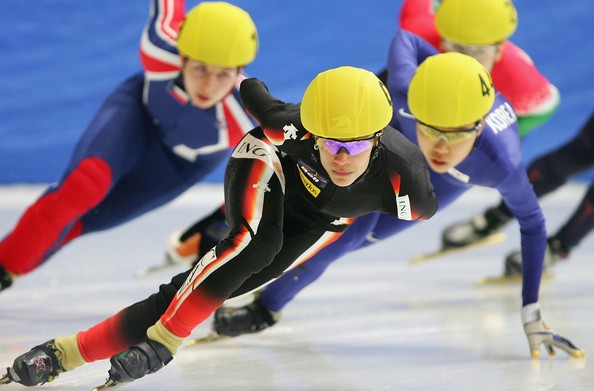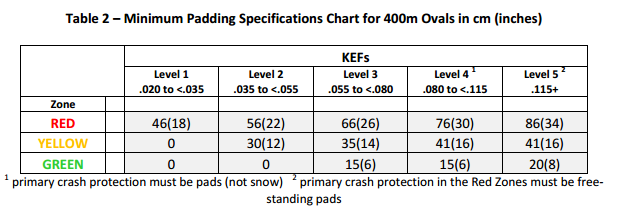
Long track speed skating, as its name suggests, is one of the fastest competition sports on the planet. With highest recorded average skater speeds of upwards of 34 MPH (54 km/h) in Olympic competition, you can very well imagine that safety is a main concern of participants and organizers of speed skating events and facilities.
As of recent, Speed Skating Canada has prepared a set of guidelines for establishing the minimum speed skating crash protection needed for both practice and competitive applications. Although these published guidelines are thought to be the utmost in safety, the organization stresses that facilities ideally should not only meet these speed skating padding standards, but exceed them to further ensure skater safety.
The specifications drawn up by Speed Skating Canada are all based on a relatively simple mathematical formula:
Kinetic Energy Factor (KEF) = (skater mass in kg)/(fastest expected lap time in seconds)²
Once you have attained the KEF value by using the above calculation, you can now reference the Speed Skating Canada guidelines by using their easy-to-use tables which will aid you in purchasing the proper amount of protective padding for you speed skating arena.
See below for a sample table from Speed Skating Canada:

They have labelled the areas of the rink into easy, color coded “zones”, each with a different level of prescribed padding based on their location.
See below for a sample of the “zones” for long track speed skating from Speed Skating Canada:

In addition to adequate skid zones and snow banks, all speed skating pads should be equipped with a vent mechanism along one of the edges of the pad. Speed skating protective padding should measure in at a minimum of 4 feet in height, should weigh less than 66 lbs and for obvious reasons, should be waterproof, slip and crack resistant to at least -40°C.
As far as foam density in the padding; anywhere from 1.3-1.8 lbs/ft³ is highly suggested, leaving the pads at a medium level of stiffness and forgiveness. These specifications and guidelines also suggest that speed skating pads used primarily outdoors, should be replaced every 7-10 years, and compressibility testing should be performed every two years, as you will want to maintain an Indentation Force Deflection (IFD) in the neighborhood of 25-40.
We at Sport Systems specialize in custom safety padding, and have experience designing, manufacturing and installing a variety of safety padding projects across a wide variety of applications. Feel free to contact our sales team for a consultation, or download our Custom Padding Guide and Request a Quote today!
For more information about Speed Skating Canada’s Safety Guidelines, please visit their website at www.speedskating.ca
.png)

